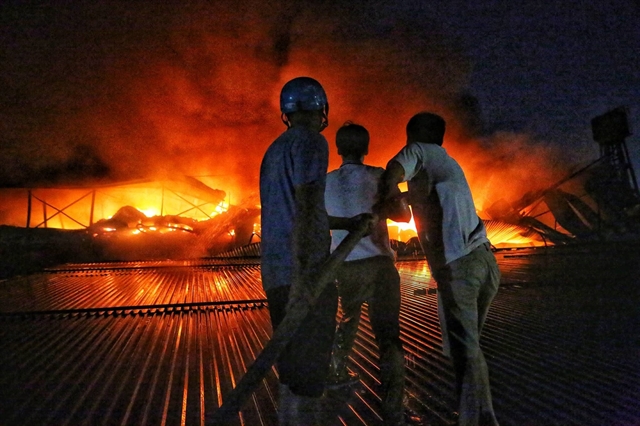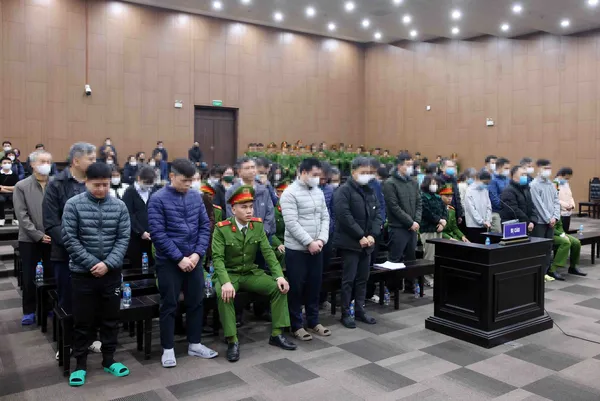 Op-Ed
Op-Ed

Thanh Xuân District should spend more time ensuring the well-being of the people, not who is authorised or not authorised to make a call – it’s simply not appropriate, especially when people are getting tired of the bureaucracy that is often decried for sluggishness and lacking compassion.

|
| Residents in the neighbourhood around Rạng Đông company climbed the roofs to assist firefighters in dousing the flames that engulfed the company's warehouse and part of its production area on August 28. — VNA/VNS Photo |
Trọng Kiên
HÀ NỘI — Exactly one week since the headline-grabbing Rạng Đông factory’s blaze in Hà Nội, the much anticipated official ‘conclusion’ regarding environmental results and health recommendations finally arrived on Wednesday.
But unfortunately, those living in the vicinity of the site and Hà Nội residents at large were unable to breathe a sigh of relief, for the official conclusion from the Việt Nam Environment Administration (VEA) just begged more questions than it answered.
Late on August 28, flames and thick smoke engulfed nearly 6,000sq.m of storage and production areas of Rạng Đông lamp company on Hạ Đình Street in a densely populated part of Thanh Xuân District – where homes are mere metres from the company’s walls.
Even though Rạng Đông has since become a household name, with no casualties, the fire didn’t strike me as something out of the ordinary. Frankly, it was a run-of-the-mill event, given how often regulations are flouted and enforcement is far from the desired level in Việt Nam.
Things got more “interesting” when the authorities of Hạ Đình ward issued a ‘notice’ a day later providing a set of fairly detailed guidelines for its residents around the factory to follow in order to ensure their health – including recommendations to not consume livestock, poultry and vegetables raised within 1km of the site, not use water from exposed sources, evacuate children and the elderly from the dust- and smoke-filled neighbourhoods, and asking people to frequently monitor their health status and report to the nearest medical stations if anomalies manifest.
All seem fairly standard protocols to follow, just in case.
With this notice, the public started to become anxious over fears of exposure – a toxic metal that is used in fluorescent lights may have be blown to all corners of Hà Nội by the incident and contaminated the air, soil and water sources.
But just a day later, in an unprecedented move, Thanh Xuân District People’s Committee retracted Hạ Đình’s notice and basically said that Hạ Đình Ward has overstepped their jurisdiction and that environmental indices evidenced by initial analyses of samples collected from surrounding areas were within normal levels so the ward’s recommendations for residents were “lacking basis”.
The district representative added that it was working with other agencies to test the quality of air and water in the area and the results will be delivered in about four days, followed by appropriate recommendations for the nearby residents.
Curiously, on the same day, the environment ministry released a notice with content similar to that of Hạ Đình Ward’s two days’ prior, but without any mention of the chemical contamination resulting from the Rạng Đông fire.
I think this is precisely when the authorities lost control of the narrative of the incident.
I feel – and I’m sure any ordinary person would not be deemed unreasonable to share the impression – that there seems to be a total lack of coordination, and worse still, a tug of war going on here, between the desire to be upfront about what happened and what risks there might be, and questionable attempts at ‘damage control’ that either aim at reducing public panic, paranoia or simply to reduce the level of embarrassment to the authorities.
Hạ Đình Ward’s notice is simply a ‘laundry list’ of precautions that people should consider, without affecting any activities of the administration and the timeliness of the notice is commendable and a responsible act, even though it might not be indeed within the ward’s position to do so.
So, with public anxiety heightened over the threats of invisible floating particles of mercury poisoining the very air they breathe and the water they drink, do the district authorities really think that people would care about the overstepping of some jurisdiction?
Thanh Xuân District should spend more time ensuring the well-being of the people, rather than paying attention to who is authorised or not authorised to make a call – it’s simply not appropriate, especially when people are getting tired of the bureaucracy that is often decried for sluggishness and lacking compassion.
Circling back to VEA’s conclusion, it said it has collected various samples of water, soil and air at different locations around the factory and found that only some samples collected within the burnt factory and at a radius of 200m from the site reported higher levels of mercury than allowed, but cautioned of possible health risks to all those living within a radius of 500m from the factory’s burnt fences.
This is also a frustrating report, in that it does sort of answer the question over whether there is contamination and at what level, but there’s nothing definitive and a dire shortage of practical measures that the residents should take: Should they close their doors all day? Should they wear masks and would normal cloth masks be enough or would they need something more specialised? Can tap water still be used, if not for drinking and cooking then to wash clothes?
It’s often said that comparisons are odious, but I cannot help invoking the story of the infamous Chernobyl disaster more than three decades ago, with the devastation being attributed as much to the negligence of the nuclear plant staff as the authorities’ obstinate initial denial of the scope and severity of the incident, for they could not risk admitting that their proud symbol of scientific and technological achievement might not be all that infallible.
In a space devoid of reliable information from mainstream sources, fake news and conspiracy theories – which I don’t think warrant a platform by repeating them here – take root and once they do, it’s hard for the belated official information – no matter how truthful and accurate it might be – to replace its sinister counterparts.
To prevent fake news from spawning, fast responses and acts of building trust could be enough to win the intended audience back from the sensationalist thinkpieces and downright 'alternative facts' spawned by those with an agenda.
Beyond just a wake-up call on chemical management or relocation of industrial production plants out of residential areas, this whole Rạng Đông saga should be studied meticulously by all levels of government to glean lessons on what to do and what not do in case of a crisis.
To start, it might be keeping an open line of communication with the public, especially those residents in high-risk areas, issuing timely guidance and recommendations, setting up a task force to deal with the situation, and constantly updated reports of changing environmental indices, which the public can access with ease.
Above all, there should be well-oiled coordination and a reasonable protocol in place that prioritises people's interests. I don't think these are too much to ask for.
On September 5, residents in the Rạng Đông neighbourhood have started to show up at the factory to demand answers and compensation, while many are temporarily moving from their homes until they are convinced they are safe. As serious containment and clean-up operations have just commenced, the story is far from over. — VNS




